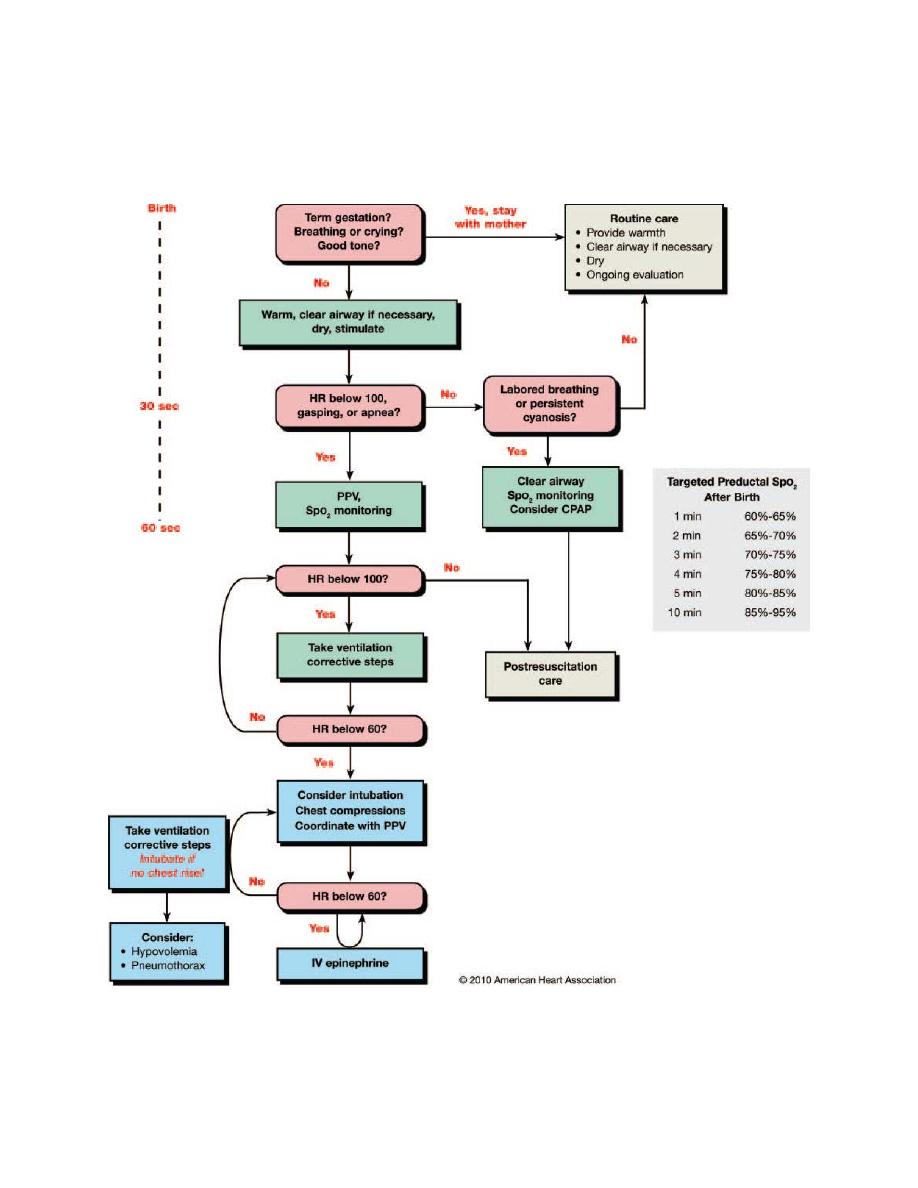
Lecture 6
PROFESSOR DR. NUMAN NAFIE HAMEED
اﻻﺳﺘﺎذ
اﻟﺪﻛﺘﻮر
ﻧﻌﻤﺎن
ﻧﺎﻓﻊ
اﻟﺤﻤﺪاﻧﻲ
Neonatal Resuscitation Program (NRP) 2010
MCQ?
In neonatal resuscitation program, the preterm neonates need special preparations
because they have all the following Except:
a. Preterm babies also have immature blood vessels in the brain that are
prone to hemorrhage
b. Have no susceptibility to infection
c. They are also more vulnerable to injury by positive-pressure ventilation.
d. increased risk of hypovolemic shock related to small blood volume
e. thin skin and a large surface area, which contribute to rapid heat loss
Approximately 10% of newborns require some assistance to begin breathing at
birth. Less than 1% requires extensive resuscitative measures. Although the vast
majority of newly born infants do not require intervention to make the transition
from intrauterine to extrauterine life, because of the large total number of births, a
sizable number will require some degree of resuscitation.
Those newly born infants who do not require resuscitation can generally be
identified by a rapid assessment of the following 3 characteristics:
● Term gestation?
● Crying or breathing?
● Good muscle tone?
If the answer to all 3 of these questions is “yes,” the baby does not need
resuscitation and should not be separated from the mother. The baby should be
dried, placed skin-to-skin with the mother, and covered with dry linen to maintain
temperature. Observation of breathing, activity, and color should be ongoing.
If the answer to any of these assessment questions is “no,” the infant should
receive one or more of the following 4 categories of action in sequence:
A. Initial steps in stabilization (provide warmth, clear airway if necessary, dry,
stimulate)
B. Ventilation
C. Chest compressions
D. Administration of epinephrine and/or volume expansion
1

Approximately 60 seconds (“the Golden Minute”) are allotted for completing the
initial steps, reevaluating, and beginning ventilation if required.
The decision to progress beyond the initial steps is determined by simultaneous
assessment of 2 vital characteristics: respirations (apnea, gasping, or labored or
unlabored breathing) and heart rate (whether greater than or less than 100 beats per
minute).
Assessment of heart rate should be done by intermittently auscultating the
precordial pulse. When a pulse is detectable, palpation of the umbilical pulse can
also provide a rapid estimate of the pulse.
A pulse oximeter can provide a continuous assessment of the pulse without
interruption of other resuscitation measures.
Once positive pressure ventilation or supplementary oxygen administration is
begun, assessment should consist of simultaneous evaluation of 3 vital
characteristics: heart rate, respirations, and the state of oxygenation, the latter
optimally determined by a pulse oximeter.
The most sensitive indicator of a successful response to each step is an increase in
heart rate.
Anticipation of Resuscitation Need
At every delivery there should be at least one person whose primary responsibility
is the newly born. This person must be capable of initiating resuscitation, including
administration of positive-pressure ventilation and chest compressions. Either that
person or someone else who is promptly available should have the skills required
to perform a complete resuscitation, including endotracheal intubation and
administration of medications. With careful consideration of risk factors, the
majority of newborns who will need resuscitation can be identified before birth.
If a preterm delivery (37 weeks of gestation) is expected, special preparations will
be required because:
1. Preterm babies have immature lungs that may be more difficult to ventilate and
are also more vulnerable to injury by positive-pressure ventilation
2. Preterm babies also have immature blood vessels in the brain that are prone to
hemorrhage
3. Thin skin and a large surface area, which contribute to rapid heat loss
4. increased susceptibility to infection
5. Increased risk of hypovolemic shock related to small blood volume.
Initial Steps
The initial steps of resuscitation are to provide warmth by placing the baby under a
radiant heat source, positioning the head in a “sniffing” position to open the
airway, clearing the airway if necessary with a bulb syringe or suction catheter,
drying the baby, and stimulating breathing.
2

Temperature Control
Very low-birth-weight (<1500 g) preterm babies are likely to become hypothermic
despite the use of traditional techniques for decreasing heat loss.
additional warming techniques are recommended (eg. prewarming the delivery
room to 26°C, covering the baby in plastic wrapping, placing the baby on an
exothermic mattress, and placing the baby under radiant heat .
The infant’s temperature must be monitored closely.
Other techniques for maintaining temperature during stabilization (eg, prewarming
the linen, drying and swaddling, placing the baby skin-to-skin with the mother and
covering both with a blanket) are recommended.
All resuscitation procedures, including endotracheal intubation, chest
compression, and insertion of intravenous lines, can be performed with these
temperature-controlling interventions in place.
Infants born to febrile mothers have been reported to have a higher incidence of
perinatal respiratory depression, neonatal seizures, and cerebral palsy and an
increased risk of mortality. Hyperthermia should be avoided.
The goal is to achieve normothermia and avoid iatrogenic hyperthermia.
Clearing the Airway When Amniotic Fluid Is Clear
There is evidence that suctioning of the nasopharynx can create bradycardia during
resuscitation and that suctioning of the trachea in intubated babies receiving
mechanical ventilation in the neonatal intensive care unit (NICU) can be associated
with deterioration of pulmonary compliance and oxygenation and reduction in
cerebral blood flow velocity when performed routinely (ie, in the absence of
obvious nasal or oral secretions).
However, there is also evidence that suctioning in the presence of secretions can
decrease respiratory resistance.
Therefore it is recommended that suctioning immediately following birth should
be reserved for babies who have obvious obstruction to spontaneous breathing or
who require positive-pressure ventilation (PPV).
When Meconium is Present Aspiration of meconium before delivery, during birth,
or during resuscitation can cause severe meconium aspiration syndrome (MAS).
In the absence of randomized, controlled trials, there is insufficient evidence to
recommend a change in the current practice of performing endotracheal suctioning
of nonvigorous babies with meconium-stained amniotic fluid .
However, if attempted intubation is prolonged and unsuccessful, bag-mask
ventilation should be considered, particularly if there is persistent bradycardia.
Assessment of Oxygen Need and Administration of Oxygen
Blood oxygen levels in uncompromised babies generally do not reach extrauterine
values until approximately 10 minutes following birth. Oxyhemoglobin saturation
3

may normally remain in the 70% to 80% range for several minutes following birth,
thus resulting in the appearance of cyanosis during that time.
Pulse Oximetry
It is recommended that oximetry be used when
1. Resuscitation can be anticipated,
2. When positive pressure is administered for more than a few breaths,
3. When cyanosis is persistent,
4. Or when supplementary oxygen is administered
Administration of Supplementary Oxygen
It is recommended that the goal in babies being resuscitated at birth, whether born
at term or preterm, should be an oxygen saturation value in the interquartile range
of preductal saturations measured in healthy term babies following vaginal birth at
sea level.
These targets may be achieved by initiating resuscitation with air or a blended
oxygen and titrating the oxygen concentration to achieve an SpO2 in the target
range.
If blended oxygen is not available, resuscitation should be initiated with air.
If the baby is bradycardic (HR <60 per minute) after 90 seconds of resuscitation
with a lower concentration of oxygen, oxygen concentration should be increased to
100% until recovery of a normal heart rate.
Positive-Pressure Ventilation (PPV)
If the infant remains apneic or gasping, or if the heart rate remains <100 per minute
after administering the initial steps, start PPV.
Initial Breaths and Assisted Ventilation
Assisted ventilation should be delivered at a rate of 40 to 60 breaths per minute to
promptly achieve or maintain a heart rate>100 per minute.
End-Expiratory Pressure
Many experts recommend administration of continuous positive airway pressure
(CPAP) to infants who are breathing spontaneously, but with difficulty, following
birth.
Starting infants on CPAP reduced the rates of intubation and mechanical
ventilation, surfactant use, and duration of ventilation, but increased the rate of
pneumothorax.
4

Spontaneously breathing preterm infants who have respiratory distress may be
supported with CPAP or with intubation and mechanical ventilation.
Nevertheless, PEEP is likely to be beneficial and should be used if suitable
equipment is available. PEEP can easily be given with a flow-inflating bag or T-
piece resuscitator.
Assisted-Ventilation Devices
Effective ventilation can be achieved with either a flow inflating or self-inflating
bag or with a T-piece mechanical device designed to regulate pressure.
Laryngeal Mask Airways
Laryngeal mask airways that fit over the laryngeal inlet have been shown to be
effective for ventilating newborns weighing more than 2000 g or delivered>34
weeks gestation.
There are limited data on the use of these devices in small preterm infants, ie,
<2000 g or <34 weeks. A laryngeal mask should be considered during resuscitation
if facemask ventilation is unsuccessful and tracheal intubation is unsuccessful or
not feasible.
The laryngeal mask airway (LMA) is used in various clinical
scenarios, including the followings:
a. In neonatal resuscitation of term and large > 34 weeks preterm babies
b. In the difficult airway, such as in the Robin sequence
c. As an aid to endotracheal intubation
d. As an aid in flexible endoscopy
e. In surgical cases in place of endotracheal intubation
Endotracheal Tube Placement
Endotracheal intubation may be indicated at several points during neonatal
resuscitation:
● Initial endotracheal suctioning of non-vigorous meconium stained newborns
● If bag-mask ventilation is ineffective or prolonged
● When chest compressions are performed
● For special resuscitation circumstances, such as congenital diaphragmatic hernia
or extremely low birth weight. The timing of endotracheal intubation may also
depend on the skill and experience of the available providers.
After endotracheal intubation and administration of intermittent positive pressure,
a prompt increase in heart rate is the best indicator that the tube is in the
tracheobronchial tree and providing effective ventilation.
Exhaled CO2 detection is effective for confirmation of endotracheal tube
placement in infants, including very low-birth-weight infants.
5

Other clinical indicators of correct endotracheal tube placement are condensation
in the endotracheal tube, chest movement, and presence of equal breath sounds
bilaterally.
Chest Compressions
Chest compressions are indicated for a heart rate that is<60 per minute despite
adequate ventilation with supplementary oxygen for 30 seconds.
Because ventilation is the most effective action in neonatal resuscitation and
because chest compressions are likely to compete with effective ventilation,
rescuers should ensure that assisted ventilation is being delivered optimally before
starting chest compressions.
Compressions should be delivered on the lower third of the sternum to a depth of
approximately one third of the anterior-posterior diameter of the chest.
Two techniques have been described: compression with 2 thumbs with fingers
encircling the chest and supporting the back (the 2 thumb–encircling hands
technique) or compression with 2 fingers with a second hand supporting the back.
the 2 thumb–encircling hands technique is recommended for performing chest
compressions in newly born infants.
Compressions and ventilations should be coordinated to avoid simultaneous
delivery. The chest should be permitted to reexpand fully during relaxation, but the
rescuer’s thumbs should not leave the chest.
There should be a 3:1 ratio of compressions to ventilations with 90 compressions
and 30 breaths to achieve approximately 120 events per minute to maximize
ventilation at an achievable rate.
It is recommended that a 3:1 ratio be used for neonatal resuscitation where
compromise of ventilation is nearly always the primary cause, but rescuers should
consider using higher ratios (eg, 15:2) if the arrest is believed to be of cardiac
origin.
Respirations, heart rate, and oxygenation should be reassessed periodically, and
coordinated chest compressions and ventilations should continue until the
spontaneous heart rate is>60/ min.
Medications
Drugs are rarely indicated in resuscitation of the newly born infant.
Bradycardia in the newborn infant is usually the result of inadequate lung inflation
or profound hypoxemia, and establishing adequate ventilation is the most
important step toward correcting it.
However, if the heart rate remains <60/ min. despite adequate ventilation (usually
with endotracheal intubation) with 100% oxygen and chest compressions,
administration of epinephrine or volume expansion, or both, may be indicated.
6

Rarely, buffers, a narcotic antagonist, or vasopressors may be useful after
resuscitation, but these are not recommended in the delivery room.
Rate and Dose of Epinephrine Administration
Epinephrine is recommended to be administered intravenously. The IV route
should be used as soon as venous access is established.
The recommended IV dose is 0.01 to 0.03 mg/kg per dose. While access is being
obtained, administration of a higher dose (0.05 to 0.1 mg/kg) through the
endotracheal tube may be considered, but the safety and efficacy of this practice
have not been evaluated. The concentration of epinephrine for either route should
be 1:10,000 (0.1 mg/mL).
Volume Expansion
Volume expansion should be considered when blood loss is known or suspected
(pale skin, poor perfusion, weak pulse) and the baby’s heart rate has not responded
adequately to other resuscitative measures.
An isotonic crystalloid solution or blood is recommended for volume expansion in
the delivery room.
The recommended dose is 10 mL/kg, which may need to be repeated.
When resuscitating premature infants, care should be taken to avoid giving volume
expanders rapidly, because rapid infusions of large volumes have been associated
with intra-ventricular hemorrhage.
Post-resuscitation Care
Babies who require resuscitation are at risk for deterioration after their vital signs
have returned to normal. Once adequate ventilation and circulation have been
established, the infant should be maintained in, or transferred to an environment
where close monitoring and anticipatory care can be provided.
Naloxone
Administration of naloxone is not recommended as part of initial resuscitative
efforts in the delivery room for newborns with respiratory depression. Heart rate
and oxygenation should be restored by supporting ventilation.
Glucose
Newborns with lower blood glucose levels are at increased risk for brain injury and
adverse outcomes after a hypoxic ischemic insult, although no specific glucose
level associated with worse outcome has been identified.
Intravenous glucose infusion should be considered as soon as practical after
resuscitation, with the goal of avoiding hypoglycemia.
Induced Therapeutic Hypothermia
It is recommended that infants born at >36 weeks gestation with evolving moderate
to severe hypoxic-ischemic encephalopathy should be offered therapeutic
hypothermia.
7

The treatment should be implemented according to the studied protocols, which
currently include commencement within 6 hours following birth, continuation for
72 hours, and slow rewarming over at least 4 hours.
8

9

Equipment Needed for Intubation
• Laryngoscope with premature (Miller no. 0) and infant blades (Miller no. 1); Miller no.
00 optional for extremely premature infant
• Batteries and extra bulbs
• Endotracheal tubes, sizes 2.5, 3.0, 3.5, and 4.0 mm ID
• Stylet
• Suction apparatus (wall)
• Suction catheters: 5.0, 6.0, 8.0, and 10.0 French
• Meconium aspirator
• Oral airway
• Stethoscope
• Non–self-inflating bag (0.5 L), manometer, and tubing; self-inflating bag with reservoir,
manometer optional for self-inflating bag
• Newborn and premature mask
• Source of compressed air/O
2
with capability for blending
• Humidification and warming apparatus for air/O
2
•
Tape
• Scissors
• Magill neonatal forceps
• Elastoplast (elastic bandages)
• Cardiorespiratory monitor
• Carbon dioxide monitor or detector
• Pulse oximeter (Spo
2
)
Summary of changes since 2010 guidelines
The following are the main changes that have been made to the guidelines for
resuscitation at birth in 2015:
• Support of transition: Recognising the unique situation of the baby at birth, who
rarely requires
‘resuscitation’ but sometimes needs medical help during the process of
postnatal transition.
The term
‘support of transition’ has been introduced to better distinguish between
interventions that are needed to restore vital organ functions (resuscitation) or to
support transition.
• Cord clamping: For uncompromised babies, a delay in cord clamping of at least 1 min
from the complete delivery of the infant, is now recommended for term and preterm
babies. As yet there is insufficient evidence to recommend an appropriate time for
clamping the cord in babies who require resuscitation at birth.

• Temperature: The temperature of newly born non-asphyxiated infants should be
maintained between 36.5
◦C and 37.5 ◦C after birth. The importance of achieving this
has been highlighted and reinforced because of the strong association with mortality
and morbidity. The admission temperature should be recorded as a predictor of
outcomes as well as a quality indicator.
• Maintenance of temperature: At <32 weeks gestation, a combination of interventions
may be required to maintain the temperature between 36.5
◦C and 37.5 ◦C after
delivery through admission and stabilisation. These may include warmed humidified
respiratory gases, increased room temperature plus plastic wrapping of body and head,
plus thermal mattress or a thermal mattress alone, all of which have been effective in
reducing hypothermia.
• Optimal assessment of heart rate: It is suggested in babies requiring resuscitation
that the ECG can be used to provide a rapid and accurate estimation of heart rate.
• Meconium: Tracheal intubation should not be routine in the presence of meconium
and should only be performed for suspected tracheal obstruction. The emphasis should
be on initiating ventilation within the first minute of life in non-breathing or
ineffectively breathing infants and this should not be delayed.
• Air/Oxygen: Ventilatory support of term infants should start with air. For preterm
infants, either air or a low concentration of oxygen (up to 30%) should be used initially.
If, despite effective ventilation, oxygenation (ideally guided by oximetry) remains
unacceptable, use of a higher concentration of oxygen should be considered.
• Continuous Positive Airways Pressure (CPAP): Initial respiratory support of
spontaneously breathing preterm infants with respiratory distress may be provided by
CPAP rather than intubation
11



